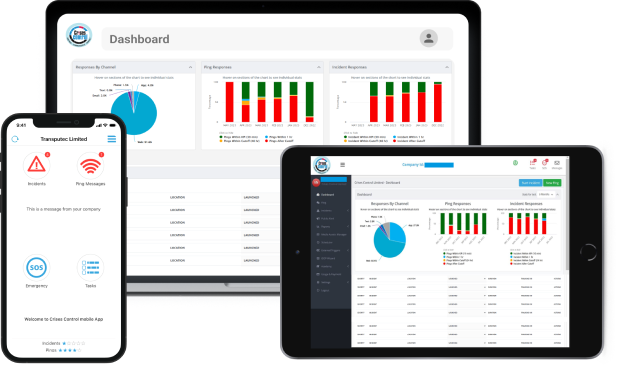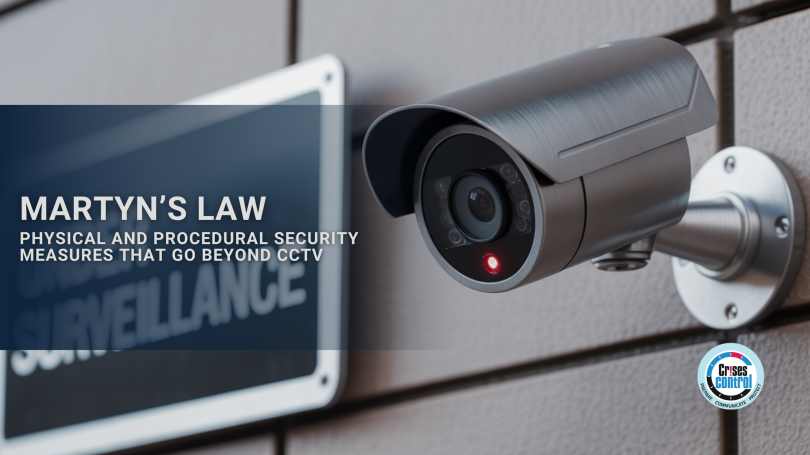Written by Anneri Fourie | Crises Control Executive
Introduction: CCTV Alone Won’t Keep People Safe
CCTV has long been a go-to security measure for public venues. But ask yourself: does it actually stop an incident from happening? Or does it just help you review what went wrong afterwards?
This is where Martyn’s Law comes in. Formally known as the Terrorism (Protection of Premises) Act, it aims to shift organisations away from passive security and towards active, well-prepared responses to potential threats. The law is designed to protect the public by ensuring that venues and events are better prepared for acts of terrorism or violence.
While many organisations are aware of the headline requirements like CCTV or general training, compliance with Martyn’s Law goes far deeper. It includes clear procedural planning, strong communication tools, and practical physical safeguards.
In this blog, we break down the specific physical and procedural security measures that will help you meet Martyn’s Law requirements, and how platforms like Crises Control can support your response strategies without adding complexity.
Understanding Martyn’s Law Procedural Requirements
Martyn’s Law divides premises into Standard and Enhanced tiers, depending on capacity and risk profile. Regardless of tier, all organisations will be expected to have clearly defined emergency procedures in place. This includes much more than just written policies.
These are live, working practices that must be understood and followed by staff, contractors and, in some cases, the public.
Key procedural requirements include:
- Emergency planning: Develop specific response plans for likely threats such as suspicious packages, hostile individuals, or active attackers.
- Role allocation: Make sure key roles are assigned before an incident occurs. For example, who is authorised to initiate a lockdown? Who handles internal and external communications?
- Regular testing: Procedures must be tested through drills, not left to sit in a binder. These tests help identify weaknesses and build confidence among staff.
This is where technology can make a real difference. With Crises Control, you can run live drills, automate role-specific tasks and ensure everyone receives the right instructions quickly and clearly. Staff don’t need to scramble for paper plans, they get the information they need, in real time, wherever they are.
What Physical Security Measures Are Required Under Martyn’s Law?
CCTV can provide useful footage, but it does not prevent or delay an incident from occurring. The physical measures encouraged under Martyn’s Law are about reducing vulnerability and increasing control during critical moments.
Examples of effective physical measures include:
- Access control: Use ID-based systems, fob entry, or security checkpoints to restrict access to authorised personnel only. Public areas should be separated from restricted spaces wherever possible.
- Instant lockdown capability: Install electronic locks that can be triggered from central control points or via mobile access. In a live incident, speed matters.
- Blast resistance: Reinforced doors, shatterproof glass, and bollards can help minimise damage and casualties in the event of an attack.
- Vehicle mitigation: Physical barriers can prevent hostile vehicles from entering pedestrian zones or vulnerable areas around the venue.
- Effective lighting: Bright, consistent lighting eliminates blind spots and supports surveillance. It also reassures the public and helps staff remain alert.
- Emergency alerts and sound systems: PA systems, alarms, or digital signage can be used to guide people quickly and calmly during an emergency.
These physical measures don’t work in isolation. They need to be part of a wider emergency response plan that links people, processes and systems together. Crises Control can integrate with physical security infrastructure, triggering alerts or lockdown sequences automatically when a threat is detected.
Access Control and Zoning: Managing Movement Inside Your Venue
In many venues, people are free to move around without much restriction. Under Martyn’s Law, this creates risk.
Every location needs to consider zoning, that is, splitting areas into public, semi-public, and private zones, each with its own level of access.
Access control best practices include:
- Visitor check-in and vetting: Particularly important for corporate offices and events, where attendees may be unfamiliar with the site layout or security rules.
- Restricted staff-only areas: Critical zones such as server rooms, control centres, or storage areas should be physically separated and protected by door access systems.
- Time-limited permissions: Contractors, temporary staff, or external partners should only be granted access for the specific timeframes and areas they require.
By combining digital access records with incident response software, you can create a responsive, accountable system. If something happens, you know who is where, and can alert the right people instantly.
Crises Control helps map digital plans to your physical spaces. If an incident occurs in Zone B, only staff in or near Zone B receive immediate instructions, avoiding confusion and unnecessary panic elsewhere.
Lockdown Procedures: Speed and Clarity Save Lives
Lockdown procedures are not just for schools or government buildings. Under Martyn’s Law, any venue with public access should have a plan for quickly securing the site.
A good lockdown plan should:
- Clearly identify secure areas and safe exit routes
- Be easy to activate, with multiple trigger methods including panic buttons, mobile devices or voice commands
- Be regularly rehearsed, with staff confident in their roles
A lockdown procedure is only as good as your ability to communicate it. You can’t rely on word of mouth or outdated call trees. You need fast, reliable messaging.
Crises Control allows you to send instant instructions across multiple channels; SMS, push notifications, email, Microsoft Teams and even voice calls, so that no matter where your people are, they know exactly what to do.
Reliable Communication Tools Are Key to Incident Response
During a fast-moving situation, your team needs more than a group chat or a loudspeaker. The most effective incident communication systems are:
- Multi-channel: Messages go out across SMS, email, mobile app and voice to ensure no one is missed.
- Role-specific: Security, leadership and external responders each receive messages tailored to their responsibilities.
- Template-driven: Pre-prepared messages save time and reduce the chance of errors in a high-pressure moment.
- Auditable: You can prove who was contacted, when they were reached, and whether they responded, a key part of compliance under Martyn’s Law.
Crises Control was built for exactly these use cases. With just one click, the right instructions can go out to the right people, with live status updates showing who has seen and acknowledged each message.
Why Integration Matters: Connect Systems, Don’t Just Add More
It’s not enough to buy a handful of tools and hope they work together. True compliance means building a coordinated system of response, from detection, to communication, to action.
With Crises Control, you can bring everything under one roof:
- Risk assessments and mitigation planning
- Real-time communication and role-based tasking
- Training simulations and compliance audits
- Integration with physical devices and site layouts
You avoid duplication, improve reaction time, and make it easier for your team to follow a clear, rehearsed process.
The Business Case: Why Going Beyond Compliance Makes Sense
Martyn’s Law provides the legal requirement. But taking action now delivers practical, everyday benefits that go far beyond compliance.
Why it matters:
- Builds trust: Being visibly prepared shows your visitors, staff and partners that you take safety seriously.
- Reduces downtime: Quick, coordinated responses limit disruption and help operations get back on track faster.
- Improves insurance position: Some insurers now ask about preparedness as part of their assessment.
- Boosts staff confidence: When people know there’s a plan and that the plan works, they feel safer and perform better.
Crises Control helps you reach these goals with a platform that adapts to your organisation’s needs. Whether you run a theatre, stadium, office block or multi-site estate, our tools provide clarity, speed and confidence when it matters most.
Take the Next Step Towards Compliance and Preparedness
Martyn’s Law is not just another regulation. It’s a call to action. Public safety is no longer optional, and neither is being prepared for the worst.
CCTV is useful, but it only tells you what happened. To actually protect people, you need procedures, communication tools, and integrated systems that allow you to act fast, clearly and effectively.
Crises Control can help you build that capability.
We provide a tested, trusted crisis management platform that supports both Standard and Enhanced Tier requirements under Martyn’s Law, from incident alerting to compliance tracking.
Book a Free Demo Today
Want to see how it works?
Contact us today for a free demo and find out how Crises Control can help you meet Martyn’s Law requirements with confidence.
Request a FREE Demo

